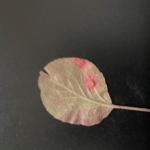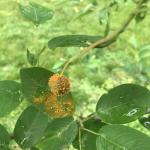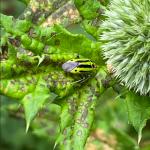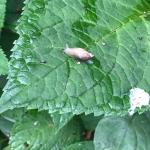UMass Extension's Landscape Message is an educational newsletter intended to inform and guide Massachusetts Green Industry professionals in the management of our collective landscape. Detailed reports from scouts and Extension specialists on growing conditions, pest activity, and cultural practices for the management of woody ornamentals, trees, and turf are regular features. The following issue has been updated to provide timely management information and the latest regional news and environmental data.
Thanks for your continuing interest! To receive immediate notification when the next Landscape Message update is posted, be sure to join our e-mail list
To read individual sections of the message, click on the section headings below to expand the content:
Scouting Information by Region
Environmental Data
The following data was collected on or about June 28, 2023. Total accumulated growing degree days (GDD) represent the heating units above a 50ºF baseline temperature collected via regional NEWA stations (http://newa.cornell.edu) for the 2023 calendar year. This information is intended for use as a guide for monitoring the developmental stages of pests in your location and planning management strategies accordingly.
|
MA Region/Location |
2023 Growing Degree Days |
Soil Temp |
Precipitation |
Time/Date of Readings |
||
| Gain since last report |
2023 total |
Sun |
Shade |
|||
|
CAPE |
141 |
654 |
72 |
68 |
2.96 |
12:00 PM 6/28/2023 |
|
SOUTHEAST |
144 |
655 |
75 |
69 |
1.70 |
3:00 PM 6/28/2023 |
|
NORTH SHORE |
133 |
621 |
72 |
65 |
0.33 |
4:00 PM 6/28/2023 |
|
EAST |
154 |
775 |
69 |
63 |
0.64 |
10:00 AM 6/28/2023 |
|
METRO |
143 |
703 |
67 |
64 |
0.23 |
6:00 AM 6/28/2023 |
|
CENTRAL |
146 |
759 |
68 |
66 |
1.94 |
7:30 AM 6/28/2023 |
|
PIONEER VALLEY |
154 |
796 |
74 |
68 |
1.45 |
2:30 PM 6/28/2023 |
|
BERKSHIRES |
130 |
620 |
70 |
65 |
2.76 |
5:45 AM 6/28/2023 |
|
AVERAGE |
143 |
698 |
71 |
66 |
1.50 |
- |
|
n/a = information not available |
||||||
US Drought Monitor: Most of eastern Barnstable County, the islands, a portion of southeastern Worcester county, and most of Berkshire county (approximately 18% of the total area of Massachusetts) are classified as "D0: Abnormally Dry" as of Thursday 6/29: https://droughtmonitor.unl.edu/CurrentMap/StateDroughtMonitor.aspx?MA
Phenology
| Indicator Plants - Stages of Flowering (BEGIN, BEGIN/FULL, FULL, FULL/END, END) | ||||||||
|---|---|---|---|---|---|---|---|---|
| PLANT NAME (Botanic / Common) | CAPE | S.E. | N.S. | EAST | METRO W. | CENT. | P.V. | BERK. |
| Lythrum salicaria (loosestrife) | * | Full | * | * | * | * | * | * |
| Hydrangea paniculata (panicle hydrangea) | * | * | Begin | * | * | Begin | Begin | * |
| Hydrangea macrophylla (bigleaf hydrangea) | Begin | Full | * | Begin | Begin | Begin | Begin/Full | * |
| Hydrangea arborescens (smooth hydrangea) | Begin/Full | Full | Begin | Begin | Begin | Begin | Begin/Full | Begin |
| Itea virginica (Virginia sweetspire) | Begin/Full | Full | Full | Full | * | Full | Full | Begin |
| Tilia cordata (littleleaf linden) | Full | Full | Full | Full | Full | Full | Full | Begin |
| Rhus typhina (staghorn sumac) | Begin/Full | Full | Full | Full | Full | Full | Full | Begin |
| Ligustrum spp. (privet) | Full | Full/End | Full | Full/End | Full | Full | End | * |
| Sambucus canadensis (American elderberry) | Begin/Full | Full/End | Full | Full | Full | Begin | Full/End | Begin/Full |
| Catalpa speciosa (Northern catalpa) | Full | Full/End | Full/End | End | End | End | End | Full |
| * = no activity to report/information not available | ||||||||
Regional Notes
Cape Cod Region (Barnstable)
General Conditions:
The average temperature for the period from June 21- June 28 was 68ºF with a high of 81ºF on June 25 and a low of 48ºF on June 22. Daytime highs have primarily been in the 70s, with lows in the 60s. The period was dominated by mostly cloudy days. Precipitation occurred on several days, totaling nearly 3 inches, the majority coming in showers on June 27 and 28. The precipitation has alleviated the abnormally dry conditions that had persisted for many weeks. Soil moisture is adequate.
Herbaceous plants seen in bloom include spiked speedwell (Veronica spicata), catmint (Nepeta spp.), tickseed (Coreopsis spp), daylily (Hemerocallis spp.), and beardtongue (Penstemon digitalis). Woody plants seen in bloom include Japanese spirea (Spiraea japonica), tree lilac (Syringa reticulata), Kousa dogwood (Cornus kousa), and oakleaf hydrangea (H. quercifolia).
Pests/Problems:
Insect or insect damage observed includes rose slug sawfly larvae on rose, cottony camellia scale on euonymus, black turpentine beetle on pitch pine, aphids on many ornamentals, and earwig damage on herbaceous plants.
Disease symptoms or signs observed this period include beech leaf disease on American beech and European beech, apple scab on crabapple, cedar-apple rust on crabapple, sycamore anthracnose on sycamore, Venturia leaf and shoot blight on poplar, exobasidium gall on deciduous azalea and huckleberry, pear trellis rust on callery pear, guignardia leaf blotch on horsechestnut, and leaf spot on river birch. Red thread is active in turf.
Weeds in bloom include black swallowwort (Cynachum nigrum), Japanese honeysuckle (Lonicera japonica), cats ear (Hypochaeris radicata), white clover (Trifolium repens), fleabane (Erigeron annuus), narrowleaf plantain (Plantago lanceolata), sheep’s bit (Jasione montana) and birdfoot trefoil (Lotus corniculatus).
Lots of rabbits in some areas. Keep yourself protected from ticks.
Southeast Region (Dighton)
General Conditions:
The weather over the past week has been dominated by tropical humidity. The daytime high temperature was 80°F on Sunday, June 25th. The morning of Wednesday June 21st had the low of 48°F. The average temperature for the week was 66°F. There were rains on Saturday-Sunday and again on Tuesday-Wednesday the 28th. Total precipitation was 1.70 inches for the week. The highest wind speed recorded was 22 mph on Tuesday June 27th.
Plants in flower: Campsis radicans (trumpet vine), Catalpa speciosa (northern catalpa), Hydrangea arborescens (smooth hydrangea), H. macrophylla (French/bigleaf hydrangea), Itea virginica (Virginia sweetspire), Ligustrum (privet), Lythrum salicaria (purple loosestrife), Rhus typhina (staghorn sumac), Sambucus canadensis (American elderberry), Tilia cordata (littleleaf linden)
Pests/Problems
High humidity from a tropical low weather system was the theme of the week along with associated thunderstorms, downpours, lightning, microbursts, and flash flooding. Growth response since the arrival of summer can already be observed in plants like the cucurbits which are suddenly "off to the races". Crabgrass is starting to tiller. Asiatic garden beetles are ovipositing (laying eggs).
North Shore (Beverly)
General Conditions:
Cloudy weather with scattered showers persisted for most of the days during this reporting period. The average daily temperature was 69ºF with the maximum temperature of 81ºF recorded on June 25 and the minimum night temperature of 49ºF recorded on June 22. Approximately 0.62 inches of rain were recorded at Long Hill. Plants in the landscape are lush and green due to rains in the last few weeks. Woody plants seen in bloom include: Japanese tree lilac (Syringa reticulata), Peking tree lilac (Syringa pekinensis), Chinese stewartia (Stewartia sinensis), Chinese sweet shrub (Calycanthus chinensis), Privet (Ligustrum spp.), Kousa dogwood (Cornus kousa), sweet azalea (Rhododendron arborescens), Virginia sweetspire (Itea virginica), smooth witherod (Viburnum nudum), oakleaf hydrangea (Hydrangea quercifolia), climbing hydrangea (Hydrangea anomala), and mountain laurel (Kalmia latifolia). Herbaceous plants in bloom include: black eyed susan (Rudbeckia hirta), Virginia rose (Rosa virginiana), spiderwort (Tradescantia spp.), leopard’s bane (Doronicum spp.), meadowsweet (Filipendula ulmaria), geranium (Pelargonium spp.), goatsbeard (Aruncus dioicus), Allium (Allium sp.), ox-eye daisy (Leucanthemum vulgare), and various annual plants.
Pests/Problems:
Imported willow leaf beetle (Plagiodera versicolora) was observed on pussy willow. Adults are small, shiny black to bluish-green oval beetles measuring about 3 mm long. Larvae are small, shiny grubs with a black head, thorax, and legs. The larvae cause the most damage by feeding on the leaf tissue, leaving only the leaf veins. Adult beetles chew holes or notches in willow leaves. Bacillus thuringiensis var. tenebrionis, horticultural oils, or insecticidal soaps can be used against the early larval stages. Cedar-apple rust (Gymnosporangium juniperi-virginianae) was observed on crabapple and cedar-quince rust (Gymnosporangium clavipes) was observed on common, single-seeded hawthorn (Crataegus monogyna). These are closely related rust diseases that require two hosts to complete their life cycle. They infect cedar and junipers and a wide range of rosaceous hosts. Avoid planting susceptible cedar and juniper varieties near susceptible rosaceous plants. For more information about cedar-quince rust, visit: https://ag.umass.edu/landscape/fact-sheets/cedar-quince-rust . Invasive Oriental bittersweet (Celastrus orbiculatus) vines are growing vigorously in the landscape. Pull out these vines when they are still young, as they can be difficult to control once they become established in the landscape. Other weeds in the landscape continue to flourish. Take measures to control weeds before they set seed.
East (Boston)
General Conditions:
We have transitioned from unseasonably cool temperatures to hot and humid days with frequent passing showers. Daytime temperatures averaged 77°F with a high of 87°F on June 25th. Overnight lows averaged 62°F. The overnight low on June 25th was 70°F. Despite the frequent showers we accumulated only 0.33 inches of precipitation over the past seven days. Geranium 'Rozanne' (cranesbill) and Magnolia virginiana (sweetbay magnolia) are flowering. Itea virginica ‘Little Henry’ (Virginia sweetspire) is putting on a show. The underutilized native Ceanothus americanus (New Jersey Tea) is flowering and attracting an abundance of pollinators.
Pests/Problems:
The recent warm, wet and humid conditions are contributing to the spread of fungal disease throughout the landscape. Powdery mildew is prevalent on Amelanchier spp. (serviceberry), Phlox paniculata (garden phlox), and Syringa spp. (lilac). Cedar-apple rust continues to infect Amelanchier spp. (serviceberry) fruit, leaves and in extreme cases has been distorting leaf stems. Rabbits continue to browse perennial borders and young woody shrubs.
Metro West (Acton)
General Conditions:
We welcome this first week of the summer season with a landscape that is lush and colorful with the green grass, foliage, and all that is in bloom and with weather that has been warm, wet, hot, and humid. For June, the historical monthly average precipitation is 3.93” and despite the many frequent, almost daily, rain events, just 3.47” of rain has been recorded so far. A high temperature of 88°F was recorded on both the 25th and a low temperature of 48°F was recorded on the 22nd.
Pests/Problems:
With the frequent precipitation, not only are our planted landscape plants thriving but the spontaneous ones are as well such as Cynachum nigrum (black swallowwort) are in full bloom. Deer have been observed feeding on the many fallen Catalpa blossoms.
Central Region (Boylston)
General Conditions:
This reporting period was relatively mild given the time of year and included a healthy amount of precipitation. Daily high temperatures ranged from 72°F to 87°F, with overnight low temperatures consistently in the high 60’s for the latter half of the period. We are experiencing a stretch of humidity and the consistent threat of thunderstorms that is typical for this time of year. There is much in bloom throughout the landscape, including smokebush (Cotinus coggygria), sweetbay magnolia (Magnolia virginiana), oakleaf hydrangea (Hydrangea quercifolia), and winterberry (Ilex verticillata).
Pests/Problems:
We’re still experiencing relatively little damage to landscape plants caused by pests and diseases. Observed this period were imported willow leaf beetle (Plagiodera versicolora) and dogwood sawfly (Macremphytus tarsatus). Mosquitoes are more active with every rainstorm and ticks are abundant.
Pioneer Valley (Amherst)
General Conditions:
The first full week of summer is behind us in the Pioneer Valley and the landscape continues to appear lush and vivid with color. Conditions this June have been cloudy and cooler than average, with numerous scattered thunderstorms this past week along with excessive humidity. Since 6/23, dew points have hovered from lower 60s to lower 70s, creating a persistently muggy feel outside. Many of the scattered thunderstorms since our last report have resulted in only minor accumulations across the valley. The Easthampton gauge has been a zone of disappointment with only 0.32″. Additional weather stations have produced the following readings: 0.39″ (Westfield), 0.68″ (Belchertown) and 0.77″ (Greenfield). The western hill towns have experienced the opposite, with heavy bands of rainfall and major accumulations ranging from 2.44″ (Blandford) to 4.08″ (Ashfield). Plants seem to be appreciating the showers and humidity. A variety of landscape trees and shrubs are producing new growth right now, such as tupelo, American elm, river birch, honeylocust, sourwood, winterberry, pin oak, red maple, Japanese maple, ginkgo, redbud, Kousa dogwood, eastern hemlock, and Chinese juniper. In a positive development, many trees injured by the 5/18 frost have flushed new growth, although some may be distorted. The harried nature of the summer growing season can make it difficult to appreciate every plant, but the time required to carefully and closely scout for disease and insect pests can also be used to admire the botanical offerings we have cultivated. The landscape is teeming with minor pests and various oddities, such slugs, earwigs and stinkhorns. Fresh mulch can produce a variety of strange and interesting fungi that can add an eclectic appeal. Weeding season is in full swing and their development in maintained beds seems unending this time of year. Eastern black swallowtail (Papilio polyxenes) caterpillars were observed on dill planted specifically to attract these native butterflies. Black flies and mosquitoes are profuse due to the persistent wet weather.
Pests/Problems:
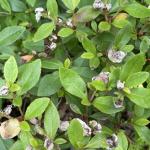
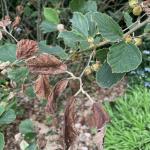 The weather recently has been truly exceptional for the development of many woody plant diseases. The high relative humidity, mild temperatures and regular rainfall has provided the necessary conditions for sporulation, dispersal, germination and establishment for many fungal pathogens. Phyllosticta leaf blotch on spring-flowering witch hazel is responsible for some significant premature leaf shedding, especially in the lower and interior portions of the canopy (see photo). Exobasidium gall is locally abundant on azalea and rhododendron (see photo). The high humidity has promoted powdery mildew fungi, which have been observed on peony, phlox, beebalm, lilac, and dogwood. Dogwood powdery mildew can result in leaf reddening and distortion, making the foliage appear wilted. It has become a bigger problem for trees in this region over the past several years. On certain crabapples, apple scab infections are widespread and premature leaf shedding later this summer should be expected. Anthracnose diseases continue to be a problem on maple, oak, and sycamore (among many others). American sycamore canopies are still thin and the highest concentration of mature foliage is mostly near the apex of the canopy. As bad as some sycamores look in the Pioneer Valley, a recent trip north along the Connecticut and West Rivers in Vermont showed that it could be worse. In areas of southern Vermont, large sycamores are devoid of any foliage and appear almost like arboreal skeletons with their white bark. With the July 4th holiday upon us, it’s safe to declare this has been a particularly bad year for the disease, perhaps rivaling 2019. Rose slug sawfly damage was observed on standard roses, although this appears to have been a great year for rose blooms. Now is a good time to treat lace bug infestations on Andromeda, azalea and rhododendron. Spinosad works very well, but the underside of the leaves must be thoroughly coated. Juniper sawfly (Monoctenus) larvae were observed on Chinese juniper. Unlike pine sawflies, they feed singly and their damage is not especially damaging. Regardless, their actions should not be allowed.
The weather recently has been truly exceptional for the development of many woody plant diseases. The high relative humidity, mild temperatures and regular rainfall has provided the necessary conditions for sporulation, dispersal, germination and establishment for many fungal pathogens. Phyllosticta leaf blotch on spring-flowering witch hazel is responsible for some significant premature leaf shedding, especially in the lower and interior portions of the canopy (see photo). Exobasidium gall is locally abundant on azalea and rhododendron (see photo). The high humidity has promoted powdery mildew fungi, which have been observed on peony, phlox, beebalm, lilac, and dogwood. Dogwood powdery mildew can result in leaf reddening and distortion, making the foliage appear wilted. It has become a bigger problem for trees in this region over the past several years. On certain crabapples, apple scab infections are widespread and premature leaf shedding later this summer should be expected. Anthracnose diseases continue to be a problem on maple, oak, and sycamore (among many others). American sycamore canopies are still thin and the highest concentration of mature foliage is mostly near the apex of the canopy. As bad as some sycamores look in the Pioneer Valley, a recent trip north along the Connecticut and West Rivers in Vermont showed that it could be worse. In areas of southern Vermont, large sycamores are devoid of any foliage and appear almost like arboreal skeletons with their white bark. With the July 4th holiday upon us, it’s safe to declare this has been a particularly bad year for the disease, perhaps rivaling 2019. Rose slug sawfly damage was observed on standard roses, although this appears to have been a great year for rose blooms. Now is a good time to treat lace bug infestations on Andromeda, azalea and rhododendron. Spinosad works very well, but the underside of the leaves must be thoroughly coated. Juniper sawfly (Monoctenus) larvae were observed on Chinese juniper. Unlike pine sawflies, they feed singly and their damage is not especially damaging. Regardless, their actions should not be allowed.
Berkshire Region (West Stockbridge)
General Conditions:
After some concern about a potential drought through much of May and early June, there has been a dramatic shift in precipitation. For example, rainfall was recorded at the North Adams airport on 18 of 28 days thus far in June. The total for the month through the 27th was 6.6 inches. Over the same stretch in Pittsfield, total rainfall was 6.21 inches, while at this site in West Stockbridge, rainfall amounted to 5.44 inches. Normal month to date (6/27) is 4.18 inches. For the past week (June 21-27), rainfall in North Adams amounted to 3.14 inches while 3.75 inches was recorded in Pittsfield and 2.76 inches fell in West Stockbridge. Obviously, soils are currently very moist though not saturated except for normally poorly draining sites. The moisture, combined with normal warm temperatures for June has spurred growth of plants and helped new set plants to get established.
Pest Problems:
Pest activity has picked up a bit with the moisture and warm temperatures. Insects observed this past scouting period include: fourlined plant bug on Forsythia and globe thistle, aphids on many herbaceous perennials and annuals, leafhoppers, imported willow leaf beetle adults and larvae, and lily leaf beetle adults. Spongy moth caterpillars are still around feeding on tree foliage but the numbers are few and damage is limited to holes in leaves as opposed to the extensive defoliation of the past two years. With all the rain, slugs and snails are prominent pests, feeding on the leaves of herbaceous plants. Leaf galls, especially on oaks and maples, are common sights at this time. Despite the rain, plant diseases are not yet very prominent except for some leaf spot on various plants. Powdery mildew has appeared on phlox. With frequent heavy rains, it can be expected that annuals planted this spring may show symptoms of nitrogen deficiency as nitrogen is quite transient. Deficiency symptoms typically include reduced growth rate and yellowing of foliage.
Regional Scouting Credits
- CAPE COD REGION - Russell Norton, Horticulture and Agriculture Educator with Cape Cod Cooperative Extension, reporting from Barnstable.
- SOUTHEAST REGION - Brian McMahon, Arborist, reporting from the Dighton area.
- NORTH SHORE REGION - Geoffrey Njue, Green Industry Specialist, UMass Extension, reporting from the Long Hill Reservation, Beverly.
- EAST REGION - Kit Ganshaw & Sue Pfeiffer, Horticulturists reporting from the Boston area.
- METRO WEST REGION – Julie Coop, Forester, Massachusetts Department of Conservation & Recreation, reporting from Acton.
- CENTRAL REGION - Mark Richardson, Director of Horticulture reporting from New England Botanic Garden at Tower Hill, Boylston.
- PIONEER VALLEY REGION - Nick Brazee, Plant Pathologist, UMass Extension Plant Diagnostic Lab, reporting from Amherst.
- BERKSHIRE REGION - Ron Kujawski, Horticultural Consultant, reporting from Great Barrington.
Woody Ornamentals
Diseases
Recent pests, pathogens, or problems of interest seen in the UMass Extension Plant Diagnostic Lab, a select few:
Dutch elm disease, caused by Ophiostoma novo-ulmi, on an old Japanese elm (Ulmus ). The tree is 128-years-old and was planted at an arboretum as a three-year-old sapling in 1898. It experiences full sun in loam-based soils, and over the past two years has received supplemental irrigation from overhead sprinklers. In early June, browning and wilting leaves developed on one large canopy leader and epicormic sprouts. It’s unclear whether wilt or flagging symptoms were present last year. Vascular staining was abundant on the submitted branch segments and the fungus was successfully incubated from symptomatic sapwood discs. The tree had been treated with propiconazole over the past two years but even active management was not able to prevent infection. Based on the samples received in the UMass Plant Diagnostic Lab, it appears that the year following a significant seasonal drought, Dutch elm disease incidence is higher. Trees are likely resisting active infections but the compounding stress of drought allows the pathogen to overtake the tree. Despite the fact that Japanese elms are highly resistant to DED, no tree is immune to the ravages of this lethal disease.
Interior needle yellowing and shedding on Alaska cedar (Callitropsis nootkatensis). Several trees at various properties are shedding needles from the inner canopy. Based on the samples submitted to the lab, this appears to be natural senescence of older needles. New growth on all the trees was robust and overall health was good. Senescent needles were mostly yellow with some scattered yellow-brown in color with no evidence of any insect pests (such as armored scales or spider mites) or needle blight pathogens common to the host. The above-average shedding may be related to last year’s drought and yews (Taxus) also appear to be shedding a larger than normal volume of older needles.
Brown rot, caused by the fungal pathogen Monilinia fructicola, on sweet cherry (Prunus avium ‘Rainier’). The tree is roughly 20-years-old and has been present at the site for 15 years. It resides in full sun within a 12’ diameter planting bed. The soil is moderately well-drained and the tree receives drip irrigation. In early June, shoot tip browning with shriveled, brown leaves was observed. Sporadic gummosis (thick, amber-colored resin production) was present on various small twigs and branches. These symptoms had not been observed in previous years. Shoot tip dieback is a common early season symptom of brown rot, which is capable of infecting several different species in genus Prunus.
Leaf blackening and shedding on a recently transplanted inkberry (Ilex glabra ′Shamrock′). The plant was installed in mid-April and a few weeks later, shed nearly all its foliage. It was planted into fresh loam soil with full sun but no supplemental irrigation. Most of the canopy branches and twigs remained green and the plant was able to flush some new foliage. The submitted material had blackened stems and leaves. The cankering pathogen Botryosphaeria was present on the woody tissue while Phyllosticta was abundant on the foliage. Both are common opportunistic pathogens of I. glabra, especially those suffering from transplant shock.
Severe case of apple scab, caused by Venturia inaequalis, on a flowering crabapple (Malus ′Donald Wyman′). The tree is roughly six-years-old and was transplanted less than one year ago. It was part of a row planting of 20 crabapples established in August of 2022. The site is on a point extending out in the ocean where fog and winds are common. The soil is described as a heavy clay but the trees receive full sun. The tree flowered normally but as the season progressed, the foliage developed spots and blotches with marginal curling and a general distortion. Venturia spore masses were covering over 50% of the submitted foliage, appearing as an olive-green, velvety coating on the leaf surface. This severe case of scab is a bit surprising given the cultivar. 'Donald Wyman' is very resistant to apple scab even in the presence of older, more susceptible cultivars. However, the site conditions and abundant rainfall the region received in late April and early May likely created a large source of primary inoculum that allowed for this high level of disease.
Report by Nick Brazee, Plant Pathologist, UMass Extension Plant Diagnostic Lab, UMass Amherst
Insects and Other Arthropods
Citizen Science Opportunity: Reporting Native Ground Nesting Bees
The Cornell College of Agriculture and Life Sciences and the Cornell Atkinson Center for Sustainability and the Ground Nesting Bees Community Science Project are asking for your help collecting data on native bee populations and nesting sites. Your contributions will help scientists better understand the importance of native bees and how to protect them in our local environments.
What to Look For: Safely monitor ground nesting bees from early spring to late summer. Entrances in grass and soil are indicators of bee activity. Upload a photo of a bee entering or exiting its nest to iNaturalist (GNbee). To learn more, visit: https://www.gnbee.org/ and upload your photos here.
Some notes on safety: take appropriate precautions if you are allergic to bee stings. While many ground nesting bees or wasps do not sting, it is not a guarantee that you will not encounter a stinging species if participating.
Interesting Insects Reported or Seen Recently:
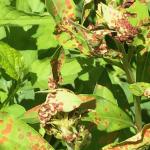
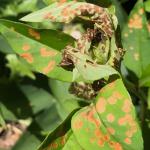 Four-lined Plant Bug: Poecilocapsus lineatus damage has been noted on garden plants in Hanson, MA as of 6/22/2023 and reported by Deborah Swanson (see photos). Deborah reports that damage at that location in Hanson, MA is particularly heightened this year. The four-lined plant bug utilizes over 250 plant species, many of which are herbaceous and including some vegetables. However, some woody ornamental plants can be fed upon by this insect, including but not limited to: Amur maple, azalea, deutzia, dogwood, forsythia, rose, sumac, viburnum, and weigela.
Four-lined Plant Bug: Poecilocapsus lineatus damage has been noted on garden plants in Hanson, MA as of 6/22/2023 and reported by Deborah Swanson (see photos). Deborah reports that damage at that location in Hanson, MA is particularly heightened this year. The four-lined plant bug utilizes over 250 plant species, many of which are herbaceous and including some vegetables. However, some woody ornamental plants can be fed upon by this insect, including but not limited to: Amur maple, azalea, deutzia, dogwood, forsythia, rose, sumac, viburnum, and weigela.
The four-lined plant bug overwinters as eggs which are inserted into the tender shoots or water sprouts of certain host plants. Females use their ovipositor to cut a slit in the tissue of the plant, into which the eggs are inserted. Clusters of eggs may be seen when leaves drop in the fall. Egg hatch may occur in late April or May in Massachusetts. Nymphs develop over the course of approximately 30 days. The color of the nymph varies as it matures, from bright red to bright yellow/orange and they have short developing wing buds during this life stage. Some eggs may hatch late, leading to an extended period over which nymphs are present. After 5 nymphal instars (molting in between each), the insect matures into an adult which is also brightly colored - forewings are bright yellow or bright green with four distinct black lines. Adults are approximately 3/16th of an inch long with fully developed wings and present for approximately one month. Adults feed on the upper surface of host plant leaves, but may be easily disturbed and quickly fly away or hide from view. There is one generation per year.
Feeding injury from both the nymphs and adults causes black or brown disease-like spots to form on the foliage of numerous hosts. The injured areas may turn black or appear translucent. After a few weeks, the necrotic tissue may drop from the plant leaving small holes behind. Some plants can outgrow the damage caused by this insect in the same season.
Prune out and destroy eggs laid in tender shoots or water sprouts prior to hatch in the spring; note that eggs can be extremely difficult to see and locate. On herbaceous hosts, thoroughly cutting back growth at the end of the season and disposing of that material may help remove overwintering eggs.
Current Nuisance Problems of Note:
- Deer Tick/Blacklegged Tick: Ixodes scapularis adults are active all winter and spring, as they typically are from October through May, and “quest” or search for hosts at any point when daytime temperatures are above freezing. Engorged females survive the winter and lay 1,500+ eggs in the forest leaf litter beginning around Memorial Day (late May). For images of all deer tick life stages, along with an outline of the diseases they carry, visit: https://www.capecod.gov/departments/cooperative-extension/programs/ticks-bugs/ or https://web.uri.edu/tickencounter/species/blacklegged-tick/.
Anyone working in the yard and garden should be aware that there is the potential to encounter deer ticks. The deer tick or blacklegged tick can transmit Lyme disease, human babesiosis, human anaplasmosis, and other diseases. Preventative activities, such as daily tick checks, wearing appropriate clothing, and permethrin treatments for clothing (according to label instructions) can aid in reducing the risk that a tick will become attached to your body. If a tick cannot attach and feed, it will not transmit disease. For more information about personal protective measures, visit: https://www.capecod.gov/departments/cooperative-extension/programs/ticks-bugs/.
The Center for Agriculture, Food, and the Environment provides a list of potential tick identification and testing resources.
*In the news: UMass Amherst has now been designated as the location for the New England Center of Excellence in Vector-Borne Diseases (NEWVEC). This CDC (Centers for Disease Control and Prevention) funded center will work to reduce the risk of vector-borne diseases spread by ticks, mosquitoes, and other blood-sucking insects or insect relatives in New England. For more information and to contact NEWVEC, visit: https://www.newvec.org/. To contact the center for more information about their Spring 2023 Project ITCH (“Is Tick Control Helping”), visit: https://www.newvec.org/itch .
Note: Dog ticks (Dermacentor variabilis) continue to be noticeably active in parts of Berkshire and Hampshire County in 2023. They are present in large numbers this year even in environments where tick activity is typically low, such as in mowed lawns.
- Mosquitoes: According to the Massachusetts Bureau of Infectious Disease and Laboratory Science and the Department of Public Health, there are at least 51 different species of mosquito found in Massachusetts. Mosquitoes belong to the Order Diptera (true flies) and the Family Culicidae (mosquitoes). As such, they undergo complete metamorphosis, and possess four major life stages: egg, larva, pupa, and adult. Adult mosquitoes are the only stage that flies and many female mosquitoes only live for 2 weeks (although the life cycle and timing will depend upon the species). Only female mosquitoes bite to take a blood meal, and this is so they can make eggs. Mosquitoes need water to lay their eggs in, so they are often found in wet or damp locations and around plants. Different species prefer different habitats. It is possible to be bitten by a mosquito at any time of the day, and again timing depends upon the species. Many are particularly active from just before dusk, through the night, and until dawn. Mosquito bites are not only itchy and annoying, but they can be associated with greater health risks. Certain mosquitoes vector pathogens that cause diseases such as West Nile virus (WNV) and eastern equine encephalitis (EEE).
Click here for more information about mosquitoes in Massachusetts.
EEE and WNV testing and tracking for this season began on June 12, 2023. The Massachusetts Department of Public Health tracks animal cases, human cases, and mosquito positive samples from traps from June through October in Massachusetts. No cases or positive samples have been reported as of June 28, 2023. Click here for more information.
There are ways to protect yourself against mosquitoes, including wearing long-sleeved shirts and long pants, keeping mosquitoes outside by using tight-fitting window and door screens, and using insect repellents as directed. Products containing the active ingredients DEET, permethrin, IR3535, picaridin, and oil of lemon eucalyptus provide protection against mosquitoes. Be aware that not all of these can be safely used on young children. Read and follow all label instructions for safety and proper use.
Click here for more information about mosquito repellents.
- Wasps/Hornets: Many wasps are predators of other arthropods, including pest insects such as certain caterpillars that feed on trees and shrubs. Adult wasps hunt prey and bring it back to their nest where young are being reared, as food for the immature wasps. A common such example are the paper wasps (Polistes spp.) who rear their young on chewed up insects. They may be seen searching plants for caterpillars and other soft-bodied larvae to feed their young. Paper wasps can sting, and will defend their nests, which are open-celled paper nests that are not covered with a papery “envelope”. These open-celled nests may be seen hanging from eaves or other outdoor building structures. Aerial yellow jackets and hornets create large aerial nests that are covered with a papery shell or “envelope”. Common yellow jacket species include those in the genus Vespula. Dolichovespula maculata is commonly known as the baldfaced hornet, although it is not a true hornet. The European hornet (Vespa crabro) is three times the size of a yellow jacket and may be confused for the northern* giant hornet (Vespa mandarinia). The European hornet is known to Massachusetts, but the northern giant hornet is not. The European hornet is known to Massachusetts, but the northern giant hornet is not. Homeowners in Massachusetts are beginning to report sightings of the European hornet in 2023. European hornets have black, tear-drop shaped markings on their abdomens, but northern giant hornets do not. If you are concerned that you have found or photographed a northern giant hornet, please report it here: https://massnrc.org/pests/report.aspx. Paper wasps and aerial yellowjackets overwinter as fertilized females (queens) and a single female produces a new nest annually in the late spring. Queens start new nests, lay eggs, and rear new wasps to assist in colony/nest development.Nests are abandoned at the end of the season. Some people are allergic to stinging insects, so care should be taken around wasp/hornet nests. Unlike the European honeybee (Apis mellifera), wasps and hornets do not have barbed stingers, and therefore can sting repeatedly when defending their nests. It is best to avoid them, and if that cannot be done and assistance is needed to remove them, consult a professional.
*Read more about the common name change for Vespa mandarinia.
Woody ornamental insect and non-insect arthropod pests to consider, a selected few:
Highlighted Invasive Insects & Other Organisms Update:
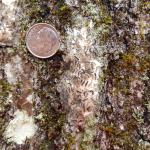
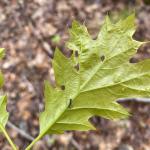
 Spongy Moth: Lymantria dispar egg hatch was reported on April 18, 2023, in Great Barrington, MA (Berkshire County) and on 5/2/2023 in Erving, MA and Millers Falls, MA (Franklin County).
Spongy Moth: Lymantria dispar egg hatch was reported on April 18, 2023, in Great Barrington, MA (Berkshire County) and on 5/2/2023 in Erving, MA and Millers Falls, MA (Franklin County).
Spongy moth caterpillars have been observed molting and passing through different instars as they develop in Berkshire County, MA. As of 6/23/2023, from Ron Kujawski: “Spongy moth caterpillars are still present and range in size from just ¼ inch to a little over an inch in length. The numbers are not as great as in the past two years and other than holes in leaves, little or no defoliation has as yet occurred.“ For updates, see the Berkshire Region report above.
The expectation is that parts of western MA may experience noticeable defoliation by this insect again in 2023. By the end of June and the beginning of July, most of this feeding will have occurred and we will be able to tell whether or not defoliation has again been significant. Additionally, by that time, whether or not the population is hit by an epizootic of the spongy moth caterpillar killing fungus (Entomophaga maimaiga) will be noticeably detectable as well.
For more information about spongy moth, view the first episode of InsectXaminer.
Why did the common name for Lymantria dispar change recently? Read more here.
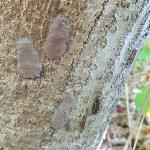 Spotted Lanternfly: (Lycorma delicatula, SLF) is a non-native, invasive insect that feeds on over 103 species of plants, including many trees and shrubs that are important in our landscapes. It overwinters as an egg mass, which the adult female insect lays on just about any flat surface. Pictures of egg masses can be seen here.
Spotted Lanternfly: (Lycorma delicatula, SLF) is a non-native, invasive insect that feeds on over 103 species of plants, including many trees and shrubs that are important in our landscapes. It overwinters as an egg mass, which the adult female insect lays on just about any flat surface. Pictures of egg masses can be seen here.
Updates about spotted lanternfly egg hatch in Massachusetts are now available from MDAR at https://massnrc.org/pests/blog/?p=3205.
SLF egg hatch has now occurred at all four locations in Massachusetts where this insect has become established. Eggs seem to have hatched earliest in Springfield, MA and at that location, MDAR reports seeing both first and second instar nymphs active at this time (as of 6/21/2023).
Currently, the only established populations of spotted lanternfly in Massachusetts are in Fitchburg, Shrewsbury, Worcester, and Springfield MA. Therefore, there is no reason to be preemptively treating for this insect in other areas of Massachusetts. If you suspect you have found spotted lanternfly in additional locations, please report it immediately to MDAR here. If you are living and working in the Fitchburg, Shrewsbury, Worcester, and Springfield, MA areas, please be vigilant and continue to report anything suspicious.
For More Information:
From UMass Extension:
*New*: Spotted Lanternfly Management Guide for Professionals
*Note that management may only be necessary in areas where this insect has become established in Massachusetts, and if high value host plants are at risk. Preemptive management of the spotted lanternfly is not recommended.
Check out the InsectXaminer Episode about spotted lanternfly adults and egg masses!
From the MA Department of Agricultural Resources (MDAR):
Spotted Lanternfly Fact Sheet and Map of Locations in MA
Spotted Lanternfly Management Guide for Homeowners in Infested Areas
*New*: Spotted Lanternfly Look-alikes in MA
*New*: Spotted Lanternfly Egg Mass Look-alikes
- Asian Longhorned Beetle: (Anoplophora glabripennis, ALB) Look for signs of an ALB infestation which include perfectly round exit holes (about the size of a dime), shallow oval or round scars in the bark where a female has chewed an egg site, or sawdust-like frass (excrement) on the ground nearby host trees or caught in between branches. Be advised that other, native insects may create perfectly round exit holes or sawdust-like frass, which can be confused with signs of ALB activity.
Adult Asian longhorned beetles typically begin to emerge from trees by July 1st in Massachusetts. By that time and throughout the rest of the summer, it is important to take photographs of and report any suspicious longhorned beetles to the Asian Longhorned Beetle Eradication Program phone numbers listed below.
The regulated area for Asian longhorned beetle is 110 square miles encompassing Worcester, Shrewsbury, Boylston, West Boylston, and parts of Holden and Auburn. If you believe you have seen damage caused by this insect, such as exit holes or egg sites, on susceptible host trees like maple, please call the Asian Lonbghorned Beetle Eradication Program office in Worcester, MA at 508-852-8090 or toll free at 1-866-702-9938.
Report an Asian longhorned beetle find online or compare it to common insect look-alikes here.
- White Spotted Pine Sawyer (WSPS): Monochamus scutellatus adults can emerge in late May throughout July, depending on local temperatures. This is a native insect in Massachusetts and is usually not a pest. Larvae develop in weakened or recently dead conifers, particularly eastern white pine (Pinus strobus). However, the white spotted pine sawyer looks very similar to the invasive Asian Longhorned Beetle, Anoplophora glabripennis, ALB. ALB adults do not emerge in Massachusetts until July and August. Beginning in July, look for the key difference between WSPS and ALB adults, which is a white spot in the top center of the wing covers (the scutellum) on the back of the beetle. White spotted pine sawyer will have this white spot, whereas Asian longhorned beetle will not. Both insects can have other white spots on the rest of their wing covers; however, the difference in the color of the scutellum is a key characteristic. See the Asian longhorned beetle entry above for more information about that non-native insect.
 Emerald Ash Borer: (Agrilus planipennis, EAB) has been detected in at least 11 out of the 14 counties in Massachusetts. A map of these locations across the state may be found at https://ag.umass.edu/fact-sheets/emerald-ash-borer . Additional information about this insect is provided by the MA Department of Conservation and Recreation at https://storymaps.arcgis.com/stories/b60f63199fa14805a8b9f7c82447a25b.
Emerald Ash Borer: (Agrilus planipennis, EAB) has been detected in at least 11 out of the 14 counties in Massachusetts. A map of these locations across the state may be found at https://ag.umass.edu/fact-sheets/emerald-ash-borer . Additional information about this insect is provided by the MA Department of Conservation and Recreation at https://storymaps.arcgis.com/stories/b60f63199fa14805a8b9f7c82447a25b.
This wood-boring beetle readily attacks ash (Fraxinus spp.) including white, green, and black ash and has also been found developing in white fringe tree (Chionanthus virginicus) and has been reported in cultivated olive (Olea europaea). Signs of an EAB infested tree may include D-shaped exit holes in the bark (from adult emergence), “blonding” or lighter coloration of the ash bark from woodpecker feeding (chipping away of the bark as they search for larvae beneath), and serpentine galleries visible through splits in the bark, from larval feeding beneath. It is interesting to note that woodpeckers are capable of eating 30-95% of the emerald ash borer larvae found in a single tree (Murphy et al. 2018). Unfortunately, despite high predation rates, EAB populations continue to grow. However, there is hope that biological control efforts will eventually catch up with the emerald ash borer population and preserve some of our native ash tree species for the future.
- Jumping Worms: Amynthas spp. earthworms, collectively referred to as “jumping or crazy or snake” worms, overwinter as eggs in tiny, mustard-seed sized cocoons found in the soil or other substrate (ex. compost). Immature jumping worms hatch from their eggs by approximately mid-to-late May. It may be impossible to see them at first, and it may be more likely that jumping worms are noticed when the first adults begin to appear at the end of May and in June. It is easy to misidentify jumping worms (ex. mistake European earthworms for jumping worms) if only juveniles are found. In August and September, most jumping worms have matured into the adult life stage and identification of infestations is more likely to occur at that time of year.
For More Information, see these UMass Extension Fact Sheets:
Earthworms in Massachusetts – History, Concerns, and Benefits
Jumping/Crazy/Snake Worms – Amynthas spp.
A Summary of the Information Shared at UMass Extension’s Jumping Worm Conference in January 2022
Invasive Jumping Worm Frequently Asked Questions (Over 70 Questions and their Answers)
Tree & Shrub Insect Pests (Native and Invasive):
- Andromeda Lace Bug: Stephanitis takeyai is most commonly encountered on Japanese Andromeda. Eggs are tiny and inserted into the midveins on the lower surface of the leaf and covered with a coating that hardens into a protective covering. 5 nymphal stages are reported. Nymphs are different in appearance from the adults, often covered with spiky protrusions. 3-4 generations per year have been observed in New England, with most activity seen between late-May into September (starting at approximately 120 GDD’s, Base 50°F). Both nymphs and adults can be seen feeding on leaf undersides. Adults have delicate, lace-like wings and what appears to be an "inflated hood" that covers their head. Adults are approximately 1/8 of an inch long. Arrived in the US in Connecticut in 1945 from Japan (Johnson and Lyon, 1991).
Can cause severe injury to Japanese andromeda, especially those in full sun. Mountain Andromeda (Pieris floribunda) is highly resistant to this pest. Like other lace bugs, this insect uses piercing-sucking mouthparts to drain plant fluids from the undersides of the leaves. Damage may be first noticed on the upper leaf surface, causing stippling and chlorosis (yellow or off-white coloration). Lace bug damage is distinguished from that of other insects upon inspecting the lower leaf surface for black, shiny spots, "shed" skins from the insects, and adult and nymphal lace bugs themselves.
A first sign of potential lace bug infestation is stippling or yellow/white colored spots or chlorosis on host plant leaf surfaces. Lace bugs excrete a shiny, black, tar-like excrement that can often be found on the undersides of infested host plant leaves. Flip leaves over to inspect for this when lace bug damage is suspected.
Mountain Andromeda (Pieris floribunda) is considered to be highly resistant to this insect and can be used as an alternative for such plantings, along with other lace bug-resistant cultivars. Consider replacing Japanese Andromeda with mountain andromeda as a way to manage for this pest. Natural enemies are usually predators, and sometimes not present in large enough numbers in landscapes to reduce lace bug populations. Structurally and (plant) species complex landscapes have been shown to reduce azalea lace bug (Stephanitis pyrioides) populations through the increase of natural enemies.
- Arborvitae Leafminer: In New England and eastern Canada, four species of leafminers are known to infest arborvitae. These include Argyresthia thuiella, A. freyella, A. aureoargentella, and Coleotechnites thujaella. The arborvitae leafminer, A. thuiella, is the most abundant of these and has the greatest known range when compared to the others. (It is also found in the Mid-Atlantic States and as far west as Missouri). Moths of this species appear from mid-June to mid-July and lay their eggs. The damage caused by all of these species is nearly identical. Trees, however, have been reported to lose up to 80% of their foliage due to arborvitae leafminer and still survive. At least 27 species of parasites have been reported as natural enemies of arborvitae leafminers, the most significant of which may be a parasitic wasp (Pentacnemus bucculatricis). Arborvitae leafminer damage causes the tips of shoots and foliage to turn yellow and brown. If infestations are light, prune out infested tips.
- Azalea Lace Bug: Stephanitis pyrioides is native to Japan. The azalea lace bug deposits tiny eggs on the midveins on leaf undersides. They then cover the area where the egg was inserted with a brownish material that hardens into a protective covering. Each female may lay up to 300 eggs (University of Florida). Nymphs hatch from the eggs and pass through 5 instars. The length of time this takes depends on temperature. Between 2 and 4 generations may be completed in a single year. In Maryland, there are four generations per year. Adults are approximately 1/10 of an inch in length with lacy, cream colored, transparent wings held flat against the back of the insect. Wings also have black/brown patches. Adults of this species also possess a "hood" over their head. Nymphs are colorless upon hatch from the egg, but develop a black color as they mature and are covered in spiny protrusions.
Immatures and adults use piercing-sucking mouthparts to remove plant fluids from leaf tissues. This feeding leaves behind white-yellow stippling on the upper surface of host plant leaves, even though the insects themselves feed on the underside of the leaf. Plants in full sun are often particularly damaged by these insects. In heavy infestations, plants in full sun may be killed by the feeding of the azalea lace bug.
Begin scouting for azalea lace bugs when 120 GDD’s (Base 50°F) are reached. This species is active throughout the summer, following. Look for dark, black tar-like spots of excrement deposited by immature and adult lace bugs on the underside of susceptible host plant leaves, especially on leaves with white-yellow stippling visible on the upper surface. If lace bugs are not already known to the location, check susceptible hosts located in full sun first. Monitor plants for lace bug feeding from late April through the summer.
Plant azaleas in partial shade. Resistance has been reported in Rhododendron atlanticum, R. arborescens, R. canescens, R. periclymenoides, and R. prunifolium.
Many of the natural enemies reported for this insect are predators. They are rarely abundant enough to reduce damaging populations of lace bugs, especially on plants in sunny locations. Structurally and (plant) species complex landscapes have been shown to reduce azalea lace bug (Stephanitis pyrioides) populations through the increase of natural enemies.
- Azalea Sawflies: There are a few species of sawflies that impact azaleas. Johnson and Lyon's Insects that Feed on Trees and Shrubs mentions three of them. Amauronematus azaleae was first reported in New Hampshire in 1895 and is likely found in most of New England. Adults of this species are black with some white markings and wasp-like. Generally green larvae feed mostly on mollis hybrid azaleas. Remember, sawfly caterpillars have at least enough abdominal prolegs to spell “sawfly” (so 6 or more prolegs). Adults are present in May, and females lay their eggs and then larvae hatch and feed through the end of June. There is one generation per year. Nematus lipovskyi has been reared from swamp azalea (Rhododendron viscosum). Adults of that species have been collected in April (in states to the south) and May (in New England) and larval feeding is predominantly in late April and May in Virginia and June in New England. One generation of this species occurs per year, and most mollis hybrid azaleas can be impacted. A third species, Arge clavicornis, is found as an adult in July and lays its eggs in leaf edges in rows. Larvae are present in August and September. Remember, Bacillus thuringiensis Kurstaki does not manage sawflies.
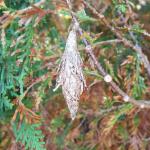 Bagworm: Thyridopteryx ephemeraeformis is a native species of moth whose larvae construct bag-like coverings over themselves with host plant leaves and twigs. This insect overwinters in the egg stage, within the bags of deceased females from last season. Eggs may hatch and young larvae are observed feeding around mid-June, or roughly between 600-900 GDD’s. Newly hatched and feeding bagworm caterpillars are small and less likely to be noticed. By late July and August, these caterpillars will be large and their feeding noticeable on individual trees and shrubs.
Bagworm: Thyridopteryx ephemeraeformis is a native species of moth whose larvae construct bag-like coverings over themselves with host plant leaves and twigs. This insect overwinters in the egg stage, within the bags of deceased females from last season. Eggs may hatch and young larvae are observed feeding around mid-June, or roughly between 600-900 GDD’s. Newly hatched and feeding bagworm caterpillars are small and less likely to be noticed. By late July and August, these caterpillars will be large and their feeding noticeable on individual trees and shrubs.- Black Vine Weevil: Otiorhynchus sulcatus adults are 0.35-0.51 inches in length and are therefore slightly larger than some of the other destructive species of Otiorhynchus. Adults are also black in color, all are female, and they cannot fly. This insect is native to Europe and is now found in the northern half of the United States and Canada. Adults will drop from foliage to the ground when disturbed and are easily hidden due to their camouflaged coloration. Adults require a few weeks of feeding before each female will lay up to 500 eggs in the soil near the base of the plant around the end of June, early-July. These eggs will hatch and larvae will burrow into the soil to feed on the roots of the plant. Larvae are white approx. 1/2 an inch in length with brown heads, legless, and C-shaped. This weevil usually overwinters as a partially developed larvae, but occasionally adults will seek shelter, such as homes, in which to overwinter. Larvae do a lot of destructive feeding in late-May, early- June just prior to pupation. Pupae are milky-white with visible appendages. One generation per year occurs in the Northeast. Many additional weevil species are pests of ornamental plants. Tiny, hemispherical notches in leaf margins are a sign of adult feeding, usually on lower branches. However, other weevils will cause this type of damage on rhododendron; it can only be used diagnostically on yew, as no other insects currently cause that type of damage on that host. The major damage is caused by larvae feeding on the rootlets. This can be a very serious pest.
Activity of the black vine weevil can be monitored using the following growing degree day ranges: 148-400 GDD's (overwintering adults; Source: Cornell Cooperative Extension) 1100–1665 GDD's (adults; Source: Robert Childs, UMass Extension), Base 50°F, March 1st Start Date. Monitor adults with crumpled burlap around plant base, as the adults hide in dark places during the day and are active at night. Pitfall traps around the base of infested plants may also be used. Look for notched leaves on host plants, particularly yew, starting in June. Larvae may be found on the roots of wilting host plants with notched leaves. Scouting is highly necessary in areas where this insect is an issue.
Some physical barriers to the adults (on the stem/base of the plant) have been suggested, since adults cannot fly and must crawl up the plant. Success varies. Knocking adults off the plant and onto a white surface, such as a sheet, so they are visible and can be collected and killed may be very time consuming (and must be done at night, when the adults are active). Some adults may be missed. Cleaning up beds and leaf litter/dropped branches can help remove favorable overwintering sites for the adults. Some rhododendrons are resistant to foliar damage.
Birds may be good predators of this insect. Beneficial nematode drenches are available for the larvae, and are most effective in containerized plants. Apply when larvae are present and when temperatures are favorable to the species of nematode being used. Follow instructions carefully as the nematodes are living organisms and proper treatment can increase efficacy (such as watering before/after nematode application).
- Boxwood Leafminer: Monarthropalpus flavus partly grown fly larvae overwinter in the leaves of susceptible boxwood. Yellowish mines may be noticeable on the undersides of leaves. This insect grows rapidly in the spring, transforming into an orange-colored pupa. After pupation, adults will emerge and white colored pupal cases may hang down from the underside of leaves where adults have emerged. Adults may be observed swarming hosts between 300-650 GDD’s, or roughly the end of May through June. Most cultivars of Buxus sempervirens and B. microphylla are thought to be susceptible. Resistant cultivars such as ‘Vardar Valley’ and ‘Handsworthiensis’ are good choices at sites where this insect has been a problem.
- Cottony Taxus Scale: Pulvinaria floccifera, also referred to as the cottony camellia scale, utilizes such hosts as taxus, camellia, holly, hydrangea, Japanese maple, euonymus, magnolia, and jasmine, among others. Females have laid the long, narrow, white and fluted egg sac that makes them much more noticeable. Eggs will hatch over an extended period of 6 weeks and crawlers may be treated between 802-1388 GDD’s. This insect can cause the host to appear off-color. They also produce honeydew which promotes sooty mold growth. Dieback is not common with this insect. Target the underside of the foliage. Horticultural oil, neem oil, and insecticidal soaps may be used to manage these soft scales. Reduced risk options help preserve natural enemies.
- Dogwood Borer: Synanthedon scitula is a species of clearwing moth whose larvae bore not only into dogwood (Cornus), but hosts also include flowering cherry, chestnut, apple, mountain ash, hickory, pecan, willow, birch, bayberry, oak, hazel, myrtle, and others. Kousa dogwood appear to be resistant to this species. Signs include the sloughing of loose bark, brown frass, particularly near bark cracks and wounds, dead branches, and adventitious growth. The timing of adult emergence can be expected when dogwood flower petals are dropping and weigela begins to bloom. Adult moth flights continue from then until September. Emergence in some hosts (ex. apple) appears to be delayed, but this differs depending upon the location in this insect’s range. Eggs are laid singly, or in small groups, on smooth and rough bark. Female moths preferentially lay eggs near wounded bark. After hatch, larvae wander until they find a suitable entrance point into the bark. This includes wounds, scars, or branch crotches. This insect may also be found in twig galls caused by other insects or fungi. Larvae feed on phloem and cambium. Fully grown larvae are white with a light brown head and approx. ½ inch long. Pheromone traps and lures are useful for determining the timing of adult moth emergence and subsequent management.
- Dogwood Sawfly: Macremphytus tarsatus has one generation per year. The larvae of the dogwood sawfly overwinter in decaying wood and occasionally compromised structural timber. An overwintering "cell" is created in this soft wood. Pupation occurs in the springtime and adults can take a lengthy time to emerge, roughly between late May and July. 100+ eggs are laid in groups on the underside of leaves. Eggs hatch and the larvae feed gregariously, initially skeletonizing leaves. As the caterpillars grow in size, they are capable of eating the entire leaf with the exception of the midvein. Larval appearance varies greatly throughout instars, so much so that one might mistake them for multiple species. Early instars are translucent and yellow, but as the caterpillars grow they develop black spots (over yellow) and become covered in a white powder-like material. Larvae and their shed skins may resemble bird droppings. Full grown larvae begin to wander in search of a suitable overwintering location. Rotting wood lying on the ground is preferred for this.
Foliage of dogwood, especially gray dogwood (Cornus racemosa) may be impacted. Skeletonizes leaves at first, then eats all but the midvein.
- Fall Webworm: Hyphantria cunea is native to North America and Mexico. It is now considered a world-wide pest, as it has spread throughout much of Europe and Asia. (For example, it was introduced accidentally into Hungary from North America in the 1940’s.) Hosts include nearly all shade, fruit, and ornamental trees except conifers. In the USA, at least 88 species of trees are hosts for these insects, while in Europe at least 230 species are impacted. In the past history of this pest, it was once thought that the fall webworm was a two-species complex. It is now thought that H. cunea has two color morphs – one black headed and one red headed. These two color forms differ not only in the coloration of the caterpillars and the adults, but also in their behaviors. Caterpillars may go through at least 11 molts, each stage occurring within a silken web they produce over the host. When alarmed, all caterpillars in the group will move in unison in jerking motions that may be a mechanism for self-defense. Depending upon the location and climate, 1-4 generations of fall webworm can occur per year. Fall webworm adult moths lay eggs on the underside of the leaves of host plants in the spring. These eggs hatch in late June or early July depending on climate. Young larvae feed together in groups on the undersides of leaves, first skeletonizing the leaf and then enveloping other leaves and eventually entire branches within their webs. Webs are typically found on the terminal ends of branches. All caterpillar activity occurs within this tent, which becomes filled with leaf fragments, cast skins, and frass. Fully grown larvae then wander from the webs and pupate in protected areas such as the leaf litter where they will remain for the winter. Adult fall webworm moths emerge the following spring/early summer to start the cycle over again. 50+ species of parasites and 36+ species of predators are known to attack fall webworm in North America. Fall webworms typically do not cause extensive damage to their hosts. Nests may be an aesthetic issue for some. If in reach, small fall webworm webs may be pruned out of trees and shrubs and destroyed. Do not set fire to H. cunea webs when they are still attached to the host plant.
- Hemlock Looper: Two species of geometrid moths in the genus Lambdina are native insects capable of defoliating eastern hemlock, balsam fir, and white spruce. Adult moths lay their eggs on the trunk and limbs of hosts in September and October, and eggs will hatch by late May or early June. (L. fiscellaria caterpillars may be active between 448-707 GDD’s.) Monitor susceptible hosts for small, inch-worm like caterpillars. Where populations are low, no management is necessary. Hemlock loopers have several effective natural enemies.
- Hibiscus Sawfly: The larvae of the hibiscus (mallow) sawfly, likely Atomacera decepta, may be observed feeding on hibiscus hosts at this time. Sawfly larvae develop into wasp-like adults (Order: Hymenoptera) and therefore these “caterpillars” will not be managed by Bacillus thuringiensis var. kurstaki which is specific to the Lepidoptera (caterpillars that develop into moths or butterflies as adults). Reduced risk active ingredients such as spinosad are labelled for use against sawfly larvae. However, given that hibiscus are very attractive to pollinators, non-chemical management options such as hand picking and disposing of larvae, when possible, are best. Spinosad is toxic to pollinators until it dries. Click here for more information about the risks of insecticide active ingredients to pollinators.
The hibiscus (mallow) sawfly adult female uses her ovipositor to cut slits into leaf surfaces to deposit her eggs. Larvae emerge from these eggs and begin by first feeding on leaf undersides when small, and then move to feed on leaf surfaces as they grow in size. Only large leaf veins may be left behind if the population is large enough. Larvae have been observed moving to the base of the plant to pupate. Adults emerge and in some locations in the US, multiple generations have been recorded per year. This insect is known in the mid-Atlantic and Midwest states, but was reported feeding on Hibiscus spp. in Connecticut in 2004 and 2005 and has previously been reported in Massachusetts. The timing of the life cycle of this insect, as well as how many generations occur per year in Massachusetts, however, is not fully understood. Some research has shown that Hibiscus acetosella, H. aculeatus, and H. grandiflora seem to either exhibit some resistance to or tolerance of hibiscus sawfly feeding. In one study, all three had few if any eggs or larvae and were given the lowest damage rating among the species evaluated. This insect also does not feed on rose of Sharon or H. rosasinensis. It has, however, been reported to “voraciously” feed on H. moscheutos, H. palustris, H. militaris, and H. lasiocarpus.
 Imported Willow Leaf Beetle: Plagiodera versicolora adult beetles overwinter near susceptible hosts. Adult beetles will chew holes and notches in the leaves of willow once they become available. Females lay yellow eggs in clusters on the undersides of leaves. Larvae are slug-like and bluish-green in color. They will feed in clusters and skeletonize the leaves. Adult imported willow leaf beetles are still very active in Boylston, MA as of 6/27/2023 on their namesake host plants. Most plants can tolerate the feeding from this insect, and foliage will appear brown. Repeated yearly feeding can be an issue, in which case management of the young larvae may be necessary. Take care with treatment in areas near water.
Imported Willow Leaf Beetle: Plagiodera versicolora adult beetles overwinter near susceptible hosts. Adult beetles will chew holes and notches in the leaves of willow once they become available. Females lay yellow eggs in clusters on the undersides of leaves. Larvae are slug-like and bluish-green in color. They will feed in clusters and skeletonize the leaves. Adult imported willow leaf beetles are still very active in Boylston, MA as of 6/27/2023 on their namesake host plants. Most plants can tolerate the feeding from this insect, and foliage will appear brown. Repeated yearly feeding can be an issue, in which case management of the young larvae may be necessary. Take care with treatment in areas near water.
Check out Episode 4 of InsectXaminer to see the imported willow leaf beetle in action.
 Lily Leaf Beetle: Lilioceris lilii adults overwinter in sheltered places. As soon as susceptible hosts such as Lilium spp. (Turk’s cap, tiger, Easter, Asiatic, and Oriental lilies) and Fritillaria spp. break through the ground, the adult lily leaf beetles are known to feed on the new foliage. (Note: daylilies are not hosts.) Adult lily leaf beetles were observed to be active in Hanson, MA on 4/14/2023. Typically, in May, mating will occur and each female will begin to lay 250-450 eggs in neat rows on the underside of the foliage. If there are only a few plants in the garden, hand picking and destroying overwintering adults can help reduce local garden-level populations at that time.
Lily Leaf Beetle: Lilioceris lilii adults overwinter in sheltered places. As soon as susceptible hosts such as Lilium spp. (Turk’s cap, tiger, Easter, Asiatic, and Oriental lilies) and Fritillaria spp. break through the ground, the adult lily leaf beetles are known to feed on the new foliage. (Note: daylilies are not hosts.) Adult lily leaf beetles were observed to be active in Hanson, MA on 4/14/2023. Typically, in May, mating will occur and each female will begin to lay 250-450 eggs in neat rows on the underside of the foliage. If there are only a few plants in the garden, hand picking and destroying overwintering adults can help reduce local garden-level populations at that time.
Check out Episode 3 of InsectXaminer to see the lily leaf beetle in action.
- River Birch Aphid/Spiny Witch-hazel Gall Aphid: Hamamelistes spinosus is currently very active on river birch in Boylston, MA as of 6/27/2023. Feeding by this species causes raised ribs or corrugated-looking galls to form on river birch leaves. The aphids themselves live on the river birch leaf undersides. These insects overwinter either as eggs on the bark of witch-hazel or as immature females beneath the bark of river birch. In the spring on river birch, the female aphids move to the newly expanding leaves where they feed and give birth to a new generation of aphids. Aphids cover themselves in a white, waxy coating when found on the undersides of birch leaves. Affected leaves may turn brown and fall off the tree, however populations of this insect can often be tolerated. A winged generation is formed on the river birch, which disperses to witch-hazel. That generation lays eggs on the witch-hazel bark which overwinter only to later hatch to form the stem mothers on that host in the spring. These individuals feed on the newly developing bugs of witch-hazel and cause them to form hollow, spiny, greenish-colored galls (may eventually turn brown) on that host. Winged individuals are formed again on witch-hazel and they disperse back to river birch. On both hosts, this insect is typically only of aesthetic interest and does not require management.
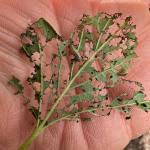 Viburnum Leaf Beetle: Pyrrhalta viburni is a beetle in the family Chrysomelidae that is native to Europe, but was found in Massachusetts in 2004. By 2008, viburnum leaf beetle was considered to be present throughout all of Massachusetts. Larvae are present and feeding on plants from approximately late April to early May until they pupate sometime in June. Much damage from viburnum leaf beetle feeding is currently apparent in areas of Massachusetts where this insect has become established. See photo courtesy of Tom Ingersoll from 6/5/2023. Adult beetles emerge from pupation by approximately mid-July and will also feed on host plant leaves, mate, and lay eggs at the ends of host plant twigs where they will overwinter. This beetle feeds exclusively on many different species of viburnum, which includes, but is not limited to, susceptible plants such as V. dentatum, V. nudum, V. opulus, V. propinquum, and V. rafinesquianum. Some viburnum have been observed to have varying levels of resistance to this insect, including but not limited to V. bodnantense, V. carlesii, V. davidii, V. plicatum, V. rhytidophyllum, V. setigerum, and V. sieboldii. More information about viburnum leaf beetle may be found at http://www.hort.cornell.edu/vlb/ and at https://ag.umass.edu/landscape/fact-sheets/viburnum-leaf-beetle.
Viburnum Leaf Beetle: Pyrrhalta viburni is a beetle in the family Chrysomelidae that is native to Europe, but was found in Massachusetts in 2004. By 2008, viburnum leaf beetle was considered to be present throughout all of Massachusetts. Larvae are present and feeding on plants from approximately late April to early May until they pupate sometime in June. Much damage from viburnum leaf beetle feeding is currently apparent in areas of Massachusetts where this insect has become established. See photo courtesy of Tom Ingersoll from 6/5/2023. Adult beetles emerge from pupation by approximately mid-July and will also feed on host plant leaves, mate, and lay eggs at the ends of host plant twigs where they will overwinter. This beetle feeds exclusively on many different species of viburnum, which includes, but is not limited to, susceptible plants such as V. dentatum, V. nudum, V. opulus, V. propinquum, and V. rafinesquianum. Some viburnum have been observed to have varying levels of resistance to this insect, including but not limited to V. bodnantense, V. carlesii, V. davidii, V. plicatum, V. rhytidophyllum, V. setigerum, and V. sieboldii. More information about viburnum leaf beetle may be found at http://www.hort.cornell.edu/vlb/ and at https://ag.umass.edu/landscape/fact-sheets/viburnum-leaf-beetle.- Yellow Poplar Weevil: Odontopus calceatus is also known as the sassafras weevil, the magnolia leafminer, or the tulip tree leafminer. This insect, as all of these common names suggest, feeds on yellow poplar (tulip tree; Liriodendron tulipifera), sassafras (Sassafras albidum), magnolia (Magnolia spp.), as well as bay laurel (Laurus nobilis). This insect is native to much of the eastern United States. Both the larvae and the adults of the yellow poplar weevil will feed on its hosts. Adults feed on the leaves and buds while the larvae mine the leaves. Adult feeding causes irregular holes to form in the leaves. Yellow poplar weevils overwinter as adults in sheltered areas, such as the leaf litter, around their hosts. In the early spring, they initiate feeding on the buds and newly opening leaves of the host plant. By May, they lay eggs in the midrib of the leaves on leaf undersides. Eggs will hatch and the larvae mine the leaves, creating blotch-like mines. This mining begins at the tip (point) of the leaf on tulip tree and Magnolia grandiflora hosts. Yellow poplar weevil larvae are white, legless, and approximately 2 mm long. Up to 9 larvae have been recorded in a single blotch mine. Larvae are mostly observed in late May and June. Pupation occurs in the leaf mines and adults of the new generation emerge to feed on leaves. Adults have been observed feeding as late as August in the southern portions of its range in the US (ex. Mississippi). Adult weevils may seek indoor shelters (such as homes) for overwintering protection. Feeding damage from this insect is not often reported as of economic importance, however in the southern parts of its range outbreaks have occasionally occurred (Johnson and Lyon, 1991). Natural enemies of the yellow poplar weevil have been reported, particularly hymenopteran parasitoids. Five species (Heterolaccus hunteri, Habrocytus piercei, Horismenus fraternus, Zagrammosoma multilineatum, and Scambus hispae) have been reported to kill 50% of yellow poplar weevil pupae (Burns and Gibson, 1968).
Concerned that you may have found an invasive insect or suspicious damage caused by one? Need to report a pest sighting? If so, please visit the Massachusetts Introduced Pests Outreach Project.
Reported by Tawny Simisky, Extension Entomologist, UMass Extension Landscape, Nursery, & Urban Forestry Program
Additional Resources
Pesticide License Exams - The MA Dept. of Agricultural Resources (MDAR) is now holding exams online. For more information and how to register, go to: https://www.mass.gov/pesticide-examination-and-licensing.
To receive immediate notification when the next Landscape Message update is posted, join our e-mail list or follow us on Facebook.
For a complete listing of landscape, nursery, and urban forestry program upcoming events, see our calendar at https://ag.umass.edu/landscape/upcoming-events.
For commercial growers of greenhouse crops and flowers - Check out UMass Extension's Greenhouse Update website.
For professional turf managers - Check out our Turf Management Updates.
For home gardeners and garden retailers - Check out our home lawn and garden resources.
Diagnostic Services
UMass Laboratory Diagnoses Landscape and Turf Problems - The UMass Extension Plant Diagnostic Lab is available to serve commercial landscape contractors, turf managers, arborists, nurseries and other green industry professionals. It provides woody plant and turf disease analysis, woody plant and turf insect identification, turfgrass identification, weed identification, and offers a report of pest management strategies that are research based, economically sound and environmentally appropriate for the situation. Accurate diagnosis for a turf or landscape problem can often eliminate or reduce the need for pesticide use. For sampling procedures, detailed submission instructions and a list of fees, see the Plant Diagnostic Laboratory web site.
Soil and Plant Nutrient Testing - The University of Massachusetts Soil and Plant Nutrient Testing Laboratory is located on the campus of The University of Massachusetts at Amherst. Testing services are available to all. The lab provides test results and recommendations that lead to the wise and economical use of soils and soil amendments. For more information, including current turn-around times, visit the UMass Soil and Plant Nutrient Testing Laboratory web site. The lab is currently accepting new orders for Routine Soil Analysis (including optional Organic Matter, Soluble Salts, and Nitrate testing), Particle Size Analysis, Pre-Sidedress Nitrate (PSNT), Total Sorbed Metals, and Soilless Media (no other types of soil analyses available at this time). Check for current turnaround time. Please plan for the fact that date of receipt in the lab is affected by weekends, holidays, shipping time, and time for UMass Campus Mail to deliver samples to the lab.
Tick Testing - The UMass Center for Agriculture, Food, and the Environment provides a list of potential tick identification and testing options at: https://ag.umass.edu/resources/tick-testing-resources.
Acknowledgements: UMass Extension gratefully acknowledges the support of the following funding sources for the production of the Landscape Message –
- The Massachusetts Nursery and Landscape Association Fund
- The Massachusetts Department of Conservation and Recreation, Award #ISADCR28219926UMA23A
- Stakeholders like you! The Landscape Message is partially supported by educational program user fees.
